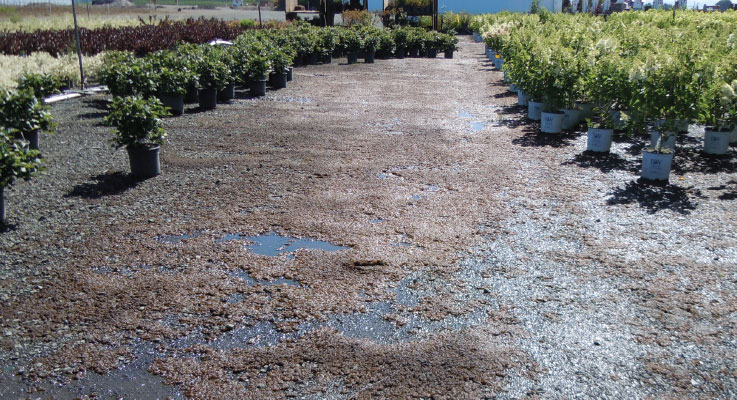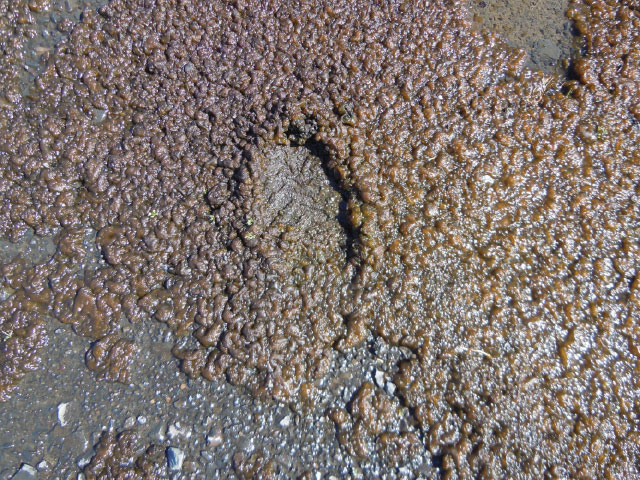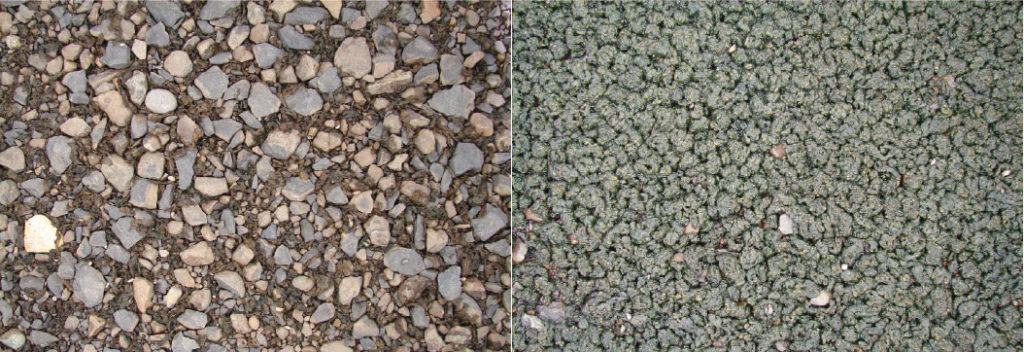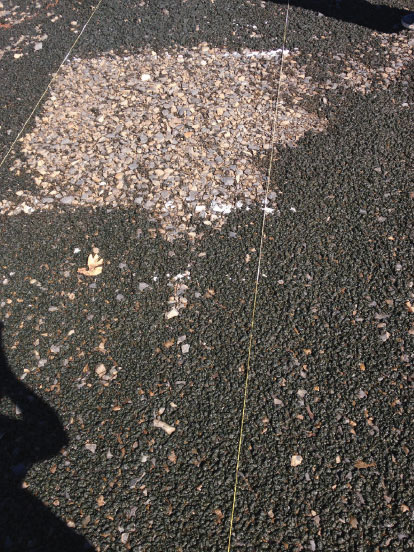
Additional treatment methods are tested against this nursery nuisance
By Heather Stoven and Jennifer Parke
Slimy colonies of the cyanobacterium Nostoc are increasingly noticeable in nurseries and sports infields throughout the country. They appear as green-to-brown-colored globby mats, which, in nurseries, grow on multiple surface types within container yards and greenhouses.
What is referred to as Nostoc is actually a grouping of several cyanobacteria species belonging to several genera which consist of both unicellular and filamentous forms. A more in-depth discussion of the biology and laboratory studies identifying the cyanobacteria conducted by Luisa Santamaria is found in the March 2016 Digger issue: tinyurl.com/yyr7xdwl

Nostoc is typically seen in areas that with ample irrigation, poor drainage and abundant nutrients. When well-hydrated, these colonies are most obvious, but when dry they become dark, flaky sheets. The unique capabilities of these organisms, however, allow them to spring back to their former glory when water is reintroduced.
As Nostoc becomes more commonly established in soil, gravel or ground cloth-covered areas in nurseries, concerns over worker safety have increased. The colonies can cause a slip hazard for workers (Figure 1). Nostoc is also visually unappealing, as it can cover the bottom of nursery containers.
Due to increased concern over this organism in nurseries, a research project was initiated in summer of 2013 with sites located at two nurseries in the Willamette Valley. Results from this research can be seen in the June 2014 issue of Digger, tinyurl.com/y6fj39e3.
In summary, copper sulfate (2.6 oz/2 gal for 1,000 sq. ft.), use of a propane burner, and solarization (clear anti-condensation plastic placed over the ground for 4 weeks) had a moderate to good effect on reducing Nostoc colonies.
Encouraged by our success, but determined to find further options for nurseries, we continued the research to evaluate additional chemical treatments.

Methods
The second field trial was conducted at a nursery in Yamhill
County. Treatments were tested in one-square-meeter pllots in a
gravel-covered roadway that was uniformly covered with Nostoc. Chemical
treatments were applied once in early July to four replicate plots per
treatment. Liquids were sprayed at a volume
of 2 gal./1000 sq. ft. Plots were visually rated four weeks later for Nostoc
coverage and vigor.
Treatments were as follows:
Untreated check
Chlorox bleach; Chlorox Company (sodium hydroxide), 12.8 oz/gal
Consan Triple Action 20; Brandt Consolidated (n-alkyl-dimethyl benzyl ammonium chlorides), 0.5 oz/gal, repeated after 1 hour
Copper sulfate pentahydrate; Chem One (copper sulfate pentahydrate) 1.3 oz/gal
Rely; Bayer CropScience (glucosinate ammonium) 2.4 oz/gal
Scythe; Dow AgroSciences (pelargonic acid), 12.8 oz/gal)
TerraCyte PRO; BioSafe Systems (sodium carbonate peroxyhydrate), 10 lb/1000 sq. ft.

Results
The experimental area continued to receive overhead irrigation throughout the trial, and Nostoc grew vigorously in the untreated plots. Visual ratings of coverage and vigor (Table 1) indicate that one product, Scythe, was very effective at killing Nostoc. Nearly all of the Nostoc in every plot treated with Scythe appeared to have been eliminated (Figure 2). Assessed four weeks after treatment, copper sulfate gave moderate control, as did TerraCyte Pro. Plots were visually inspected again seven weeks after treatment, and those treated with Scythe were still free of Nostoc, whereas all other plots were completely covered with vigorously growing Nostoc (Figure 3).
Scythe (pelargonic acid) is currently labeled for use in container nurseries, so this appears to be a good option for controlling Nostoc. The 10% rate (12.8 oz./gal) is the highest labeled rate. It is not known if lower rates would also be effective, but even at this rate it may be cost effective because a single application did provide control for at least seven weeks under conditions conducive for Nostoc growth. While pelargonic acid is certified for use in organic agriculture, care should be taken to avoid spray drift onto nursery crop plants, as it is a broad-spectrum herbicide.
Products that were moderately effective were copper sulfate (copper sulfate pentahydrate crystals, Chem One) (1.3 oz./gal) and sodium carbonate peroxyhydrate (TerraCyte PRO, Biosafe Systems) (10 lbs. granular per 1000 sq. ft.). However, copper sulfate is not labeled for application to soil or gravel, and may pose a hazard to fish and aquatic invertebrates exposed to contaminated runoff.
A note regarding these on-site nursery trials: the biological complexity which makes up Nostoc may alter the effectiveness of management techniques in some situations. As mentioned above, several species of cyanobacteria make up what is commonly referred to as Nostoc. Therefore, different compositions of the colonies may alter management results. The treatments listed above were successful at local Willamette Valley nurseries, but individual results may vary based on the biological diversity of Nostoc at different locations.
Table 1: Results for 2014 Nostoc field trial based on visual ratings of coverage and vigor four weeks after treatment,. Rating scale for coverage: 1=0-20% area, 2=20-40% area, 3=40-60% area, 4=60-80% area and 5=80-100% area). Rating scale for vigor: 1=dead to 5=healthy. Values within a column followed by the same letter are not significantly different (p<0.05).
| Treatments | Average coverage rating | Average vigor rating |
| Untreated check | 5 A | 5 A |
| Chlorox | 5 A | 5 A |
| Consan Triple Action 20 | 5 A | 5 A |
| Rely | 5 A | 5 A |
| Copper sulfate pentahydrate | 3 B | 2.25 B |
| TerraCyte PRO | 2.75 B | 3.25 B |
| Scythe | 1 C | 1 C |
Conclusions
Our research trials identified several options for Nostoc management that should fit into various nursery production systems. If Nostoc-colonized areas are free of plants during key time periods, solarization or use of propane burners can work well. In situations where chemical control is warranted, pelargonic acid (Scythe) can provide control for the longer term.
Although Nostoc is an increasing problem affecting worker safety and nursery aesthetics, there are tools available that growers can use to mitigate this issue.
NOTE: This report includes information concerning experimental use of unregistered pesticides or unregistered uses of pesticides. Experimental results should not be interpreted as recommendations for use. Use of unregistered materials or use of any registered pesticide inconsistent with its label is against both federal and state law.
Trade-name products and services are mentioned as illustrations only. This does not mean that Oregon State University endorses these products or that they intend to discriminate against products and services not mentioned.
Heather Stoven is an extension horticulturalist for Oregon State University, serving Yamhill County, Oregon. Jennifer Parke is a professor in the Department of Crop and Soil Science and the Department of Botany and Plant Pathology at Oregon State University, Corvallis.


